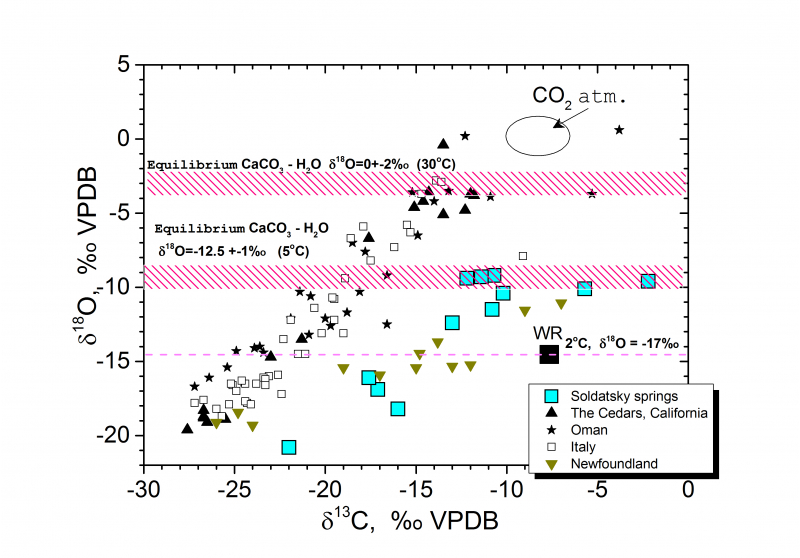
Hyperalkaline waters and travertines of the ophiolite complex of Mt. Soldatskaya, Kamchatsky Mys Peninsula, Kamchatka, Russia
ABSTRACT

We present a detailed study of hyperalkaline springs (pH > 10) sampled during fieldworks in 2022 and 2023 within the ultramafic Mt. Soldatskaya massif on the Kamchatsky Mys Peninsula in Kamchatka. The chemical composition of the springs and the dependence of the concentrations of some components on pH are consistent with the formation of these waters due to the present-day serpentinization of ultrabasic rocks. In the most alkaline springs (pH 12.59), dissolved hydrogen was detected at a concentration of about 0.8 mmol/L. Furthermore, the springs with high pH have a sodium chloride composition, with a maximal chloride content up to 300 mg/L in the springs with the highest pH. The isotopic composition of carbonate travertines deposited from these springs (δ13C and δ18O) demonstrates a trend that differs from the known trend for ‘meteogenic’ travertines, likely due to the extremely low temperatures of the springs (2–7°C). The age of the travertines, determined by the radiocarbon method, varies from modern in springs with the highest pH to approximately 6300 years for a fragment of travertine found in alluvial deposits. The Sr isotope ratio for travertines (0.7051 to 0.7070) indicates a mixed source of Sr, between magmatic rocks and marine sediments. An attempt to use data on the age and isotopic composition of travertines for paleoclimatic purposes failed: travertine aged 6300 years showed a much colder climate than the reconstruction of palobotanical data.
KEYWORDS
Keywords: hyperalkaline springs, Kamchatsky Mys Peninsula, ultramafic rocks, serpentinization, age of travertines- Published : 2024
- Released on J-STAGE : 2024/06/27
- Received : 2024/03/31
- Accepted : 2024/05/06
- DOI : https://doi.org/10.2343/geochemj.GJ24011
- J-STAGE URL : https://www.jstage.jst.go.jp/article/geochemj/58/3/58_GJ24011/_article/-char/en
- J-Online ISSN: 1880-5973
- Print ISSN : 0016-7002
- ISSN-L : 0016-7002
All Issues
- Vol.59, 2025
- Vol.58, 2024
- Vol.57, 2023
- Vol.56, 2022
- Vol.55, 2021
- Vol.54, 2020
- Vol.53, 2019
- Vol.52, 2018
- Vol.51, 2017
- Vol.50, 2016
- Vol.49, 2015
- Vol.48, 2014
- Vol.47, 2013
- Vol.46, 2012
- Vol.45, 2011
- Vol.44, 2010
- Vol.43, 2009
- Vol.42, 2008
- Vol.41, 2007
- Vol.40, 2006
- Vol.39, 2005
- Vol.38, 2004
- Vol.37, 2003
- Vol.36, 2002
- Vol.35, 2001
- Vol.34, 2000
- Vol.33, 1999
- Vol.32, 1998
- Vol.31, 1997
- Vol.30, 1996
- Vol.29, 1995
- Vol.28, 1994
- Vol.27, 1993
- Vol.26, 1992
- Vol.25, 1991
- Vol.24, 1990
- Vol.23, 1989
- Vol.22, 1988
- Vol.21, 1987
- Vol.20, 1986
- Vol.19, 1985-1986
- Vol.18, 1984
- Vol.17, 1983
- Vol.16, 1982
- Vol.15, 1981
- Vol.14, 1980
- Vol.13, 1979
- Vol.12, 1978
- Vol.11, 1977
- Vol.10, 1976
- Vol.9, 1975
- Vol.8, 1974
- Vol.7, 1973
- Vol.6, 1972-1973
- Vol.5, 1971
- Vol.4, 1970-1971
- Vol.3, 1969-1970
- Vol.2, 1968
- Vol.1, 1966-1967




